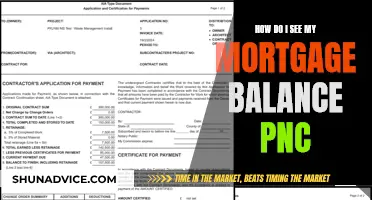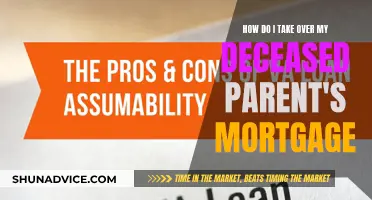
The COVID-19 pandemic has seen many people struggling to pay their rent, mortgage, and other bills and debts. In 2018, there were over 750,000 bankruptcies filed across the United States, with the average American carrying about $38,000 in debt. If you are one of those people and are considering settling a second mortgage after Chapter 7 bankruptcy, you may be wondering how to go about it.
| Characteristics | Values |
|---|---|
| Is it possible to settle a second mortgage after Chapter 7 bankruptcy? | Yes, but it depends on various factors. |
| What are some of the factors that determine eligibility for settlement? | The value of the home, the amount owed on the first mortgage, and other debts. |
| What is the process for settling a second mortgage? | Contact the second mortgage lender, discuss the debt, and make an offer. |
| What is another strategy for settling a second mortgage? | Approach the lender with a settlement offer to remove the lien on the second mortgage. |
| What is the risk associated with this strategy? | The second mortgage lender has the legal right to foreclose on the home if payments are stopped. |
| What is the benefit of settling a second mortgage? | It can provide debt relief and a fresh financial start. |
| What is the role of an attorney in this process? | A bankruptcy attorney can guide and advocate for the debtor, negotiating the best possible outcome. |
| Are there any specific cases that have impacted the process? | In re Rosa and Dewsnup v. Timm have set precedents for stripping off second mortgage liens in subsequent Chapter 13 cases. |
What You'll Learn

Negotiate with your second mortgage lender
If you're looking to settle your second mortgage after filing for Chapter 7 bankruptcy, you may be able to negotiate with your second mortgage lender. Here are some steps you can take:
Contact your second mortgage lender:
Start by reaching out to your lender to discuss your debt. Be transparent about your situation and express your interest in settling the debt. It's important to understand that settling the second mortgage is voluntary, and the lender is not obligated to accept any settlement offer.
Explain your financial situation:
Provide your lender with relevant financial information, such as a recent tax assessment, to demonstrate that your loans exceed the value of your home. This can help make a case for a settlement.
Make an offer:
Propose a settlement offer to your lender. It's common for second mortgages to be settled for between 5% and 20% of the second mortgage loan balance. Be prepared for your lender to counteroffer, especially if your initial offer is on the lower end.
Understand the risks:
Keep in mind that even if you stop making payments, the second mortgage lender has the legal right to foreclose on your home. Additionally, they may not find it cost-effective to do so, as they would incur legal costs. Therefore, it's usually in their best interest to work with you towards a settlement.
Seek legal advice:
Consider consulting a bankruptcy attorney who can guide you through the process and help you understand your rights and options. They can also assist in negotiating with your lender to achieve the best possible outcome for your financial future.
Remember that every situation is unique, and the outcome of negotiations with your second mortgage lender will depend on various factors, including your financial circumstances and the lender's policies.
Paying Off Your Mortgage Faster: Strategies for Success
You may want to see also

Make a settlement offer
If you are considering settling a second mortgage after Chapter 7 bankruptcy, it is important to understand the risks involved. While bankruptcy can provide relief from many types of debt, the treatment of second mortgages depends on various factors. One common strategy is to approach the second mortgage lender with a settlement offer to remove the lien on the second mortgage. However, settling a second mortgage is voluntary, and if you stop making payments, the lender still has the legal right to foreclose.
- Contact your second mortgage lender to discuss the debt. Express your interest in paying off the debt and explain your situation, especially if your property is in foreclosure.
- Offer to provide your most recent tax assessment to show that your loans exceed the value of your home. This is important because, in a Chapter 7 bankruptcy proceeding, a debtor can be relieved of debts if their mortgage greatly exceeds the home's value.
- Make an offer to your second mortgage lender. It is common for second mortgages to be settled for between 5% and 20% of the second mortgage loan balance.
- Expect a counteroffer from your lender, especially if your initial offer is low.
- Put the agreement in writing. Once you agree on a settlement number, ask your lender for a written agreement before making any payments.
It is important to note that Chapter 7 bankruptcy does not remove mortgage liens from your home. However, if you can prove that your second mortgage is wholly unsecured, you may be able to use lien stripping to remove the lien and eliminate the debt.
Reaffirming Your Mortgage After Chapter 7: What You Need to Know
You may want to see also

Prove your second mortgage is unsecured
A second mortgage is a loan taken out against a property that already has a home loan on it. In other words, your lender has the right to take control of your home if you default on your loan. When you take out a second mortgage, a lien is taken out against the portion of your home that you've paid off.
Second mortgages are typically considered secured debt, which means that they have collateral behind them (your home). However, in some cases, a second mortgage may be unsecured. This typically occurs when the value of the home is exceeded by the mortgage on it. In such cases, the second mortgage can be stripped off in a Chapter 7 bankruptcy proceeding, relieving the debtor of the debt.
To prove that your second mortgage is unsecured, you will need to demonstrate that the value of your home is less than the total amount of your mortgage loans. This can be done by obtaining a professional appraisal of your home's value and comparing it to the outstanding balance on your first and second mortgages. If the appraised value is less than the total loan amount, your second mortgage may be considered unsecured.
It is important to note that the laws and procedures surrounding bankruptcy and mortgage relief can be complex and vary by location. Seeking the advice of a skilled bankruptcy attorney can be crucial in understanding your rights and options. They can guide you through the process and help you make informed decisions to achieve long-term financial stability.
Mortgage Freedom: Marking Your Loan as Paid Off
You may want to see also

File a Chapter 13 bankruptcy case
Chapter 13 bankruptcy is also called a wage earner's plan. It is available to wage earners, the self-employed, and sole proprietors. It enables individuals with regular income to develop a plan to repay all or part of their debts. Under this chapter, debtors propose a repayment plan to make installments to creditors over three to five years. If the debtor's current monthly income is less than the applicable state median, the plan will be for three years unless the court approves a longer period. If the debtor's current monthly income is greater than the applicable state median, the plan generally must be for five years. In no case may a plan provide for payments over a period longer than five years.
Before filing for Chapter 13, bankruptcy laws require you to complete a credit counseling course from a U.S. Department of Justice U.S. Trustee Program-approved agency. This course helps assess whether you make enough money to pay back those you owe. The course must be taken within 180 days before filing for bankruptcy. The counseling fee is about $50. First, find a bankruptcy lawyer who will give you a free evaluation and estimate of what you'll have to pay to file. The cost to file Chapter 13 bankruptcy consists of a $313 filing fee and fees charged by a bankruptcy attorney.
The trustee will review the debts and income statements, and then schedule a hearing to decide whether the plan is acceptable. When the repayments are completed, the Chapter 13 case will be discharged. Debts not discharged in chapter 13 include certain long-term obligations (such as a home mortgage), debts for alimony or child support, certain taxes, debts for most government-funded or guaranteed educational loans or benefit overpayments, debts arising from death or personal injury caused by driving while intoxicated or under the influence of drugs, and debts for restitution or a criminal fine included in a sentence on the debtor's conviction of a crime.
Maximizing Mortgage Savings: Strategies for Financial Freedom
You may want to see also

Consult a bankruptcy attorney
If you are considering settling a second mortgage after Chapter 7 bankruptcy, consulting a bankruptcy attorney is a crucial step to take. Here are several reasons why:
Bankruptcy attorneys are knowledgeable and experienced professionals who can guide you through the complex legal process of settling your second mortgage. They understand the nuances of bankruptcy law and can explain your rights, options, and the potential risks associated with different choices. This guidance can empower you to make informed decisions and set yourself up for long-term financial stability.
A bankruptcy attorney can review your specific circumstances, including your financial situation, the details of your second mortgage, and the applicable state and federal laws. By understanding your unique context, they can provide tailored advice and strategies that are most likely to lead to a positive outcome for you.
These legal professionals can also assist in negotiations with your second mortgage lender. They can help you understand the lender's perspective and work with you to develop a settlement offer or loan modification proposal that has a higher chance of being accepted. They can advocate for your interests and protect you from potential pitfalls or unfair treatment during the negotiation process.
In addition, bankruptcy attorneys can provide emotional support and peace of mind during a stressful time. Financial hardship can be overwhelming, and having an expert by your side can offer a sense of reassurance. They can answer your questions, address your concerns, and ensure you feel respected and understood throughout the process.
Finally, consulting a bankruptcy attorney can help you explore all your options, including alternatives to Chapter 7 bankruptcy. They can explain the pros and cons of different bankruptcy chapters or other debt relief strategies, ensuring you make the most informed decision for your specific situation.
Remember, bankruptcy is a common occurrence, and seeking legal assistance can be a crucial step towards financial recovery.
Paying Off Your Mortgage: Strategies for Financial Freedom
You may want to see also
Frequently asked questions
Filing for Chapter 7 bankruptcy can open the door to negotiations with your second mortgage lender. You can approach the second mortgage with a settlement offer to remove the lien on your second mortgage. However, it is important to note that settling is voluntary, and if you stop making payments, the lender has the right to foreclose.
Contact your second mortgage lender to discuss the debt and express your interest in paying it off. Explain your situation and offer to provide a recent tax assessment to show that your loans exceed the value of your home. Make an offer to your lender, and be prepared for a counteroffer, especially if you start low. Second mortgages are usually settled for between 5 and 20 percent of the loan balance.
Yes, a second mortgage can be discharged in Chapter 7 if it is wholly unsecured. In this case, you can use lien stripping to remove the lien from your property and potentially eliminate the debt.
Lien stripping is a process that allows you to remove a lien from your property. In the context of a second mortgage, if the second mortgage is not secured by any value, you can strip the lien without paying anything to the second mortgage lender.







